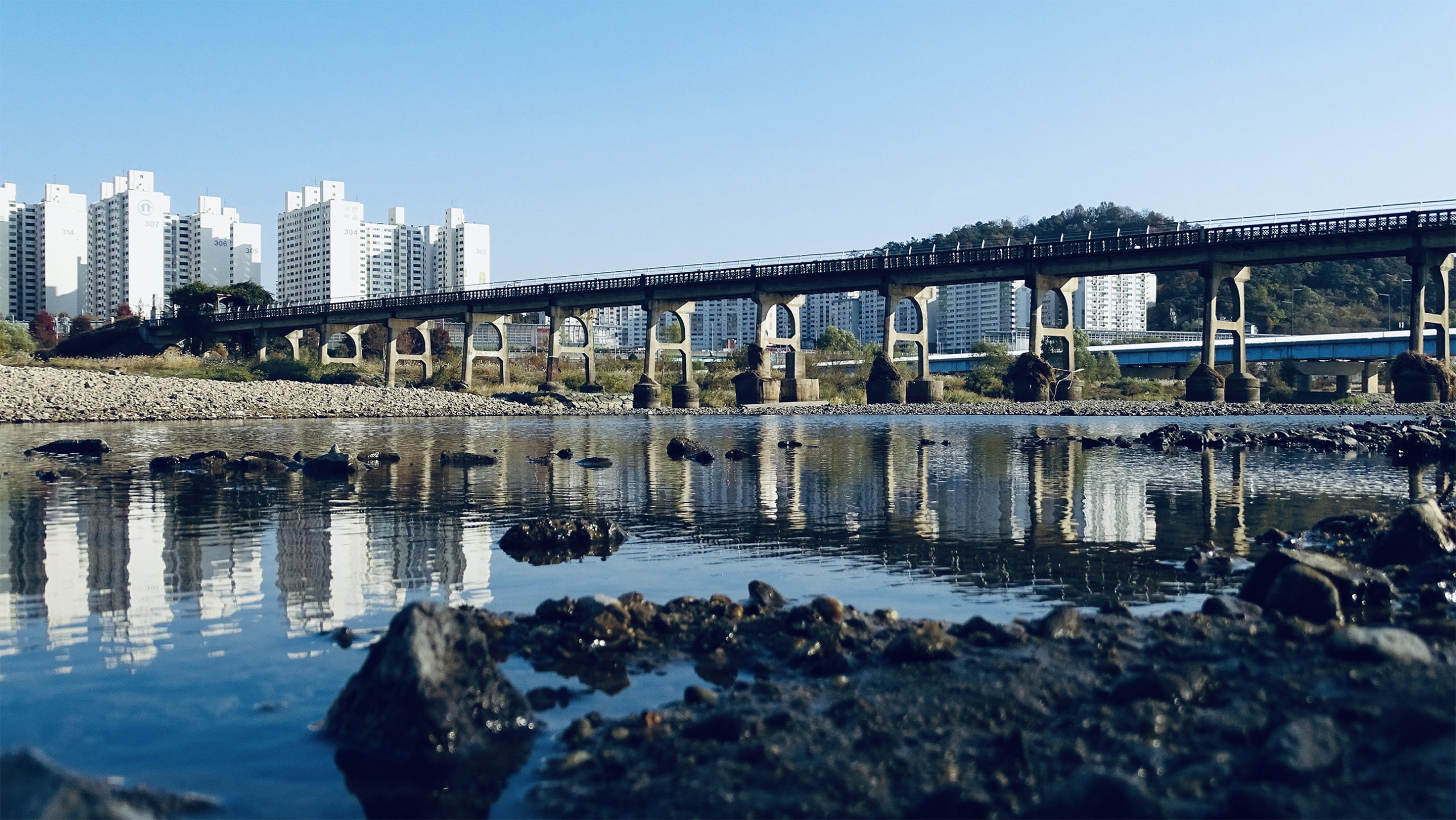Water Over the Bridge
Written and photographed by Isaiah Winters.
The year 2020 has offered several powerful reminders of how thin the veneer of stability can be. One such reminder was seen in how the city’s waterways could ripple with tranquil beauty one day and then rip through neighborhoods the next, as demonstrated by this rainy season’s deluge. As an homage to the city’s waterways, the year’s final Lost in Gwangju will begin in one particularly hard-hit area of the city, where normally subterranean streams reared their ugly heads to devastating effect. As this is the exception rather than the rule, the remaining balance of this article will feature the placid allure of two historically significant waterfront sites. One is a longstanding bridge spanning the 70 years between the Korean War and today, while the other is a stunning riverside pavilion that’s been faithfully restored atop the same hilly outcrop again and again for over four centuries. This careening between beauty and chaos perfectly encapsulates the past year and makes for a great send-off.
Circling the Drain (Sinan-dong)
Gwangju has many underground streams that were simply paved over in the city’s ongoing mad rush to develop. Of course, they still flow today, though largely out of sight several meters beneath the city streets. Two of particular interest are the Seobang and Yongbong streams that run along Chonnam National University before merging beneath Sinan-dong. These humble tributaries to the larger Gwangju Stream eventually spill out from beneath a large three-way intersection in the area, though you can usually smell their confluence long before you see it. During the especially heavy rains of this summer, their malodorous coupling brought far more to the surface than just the usual reek of sewage and sulfur.
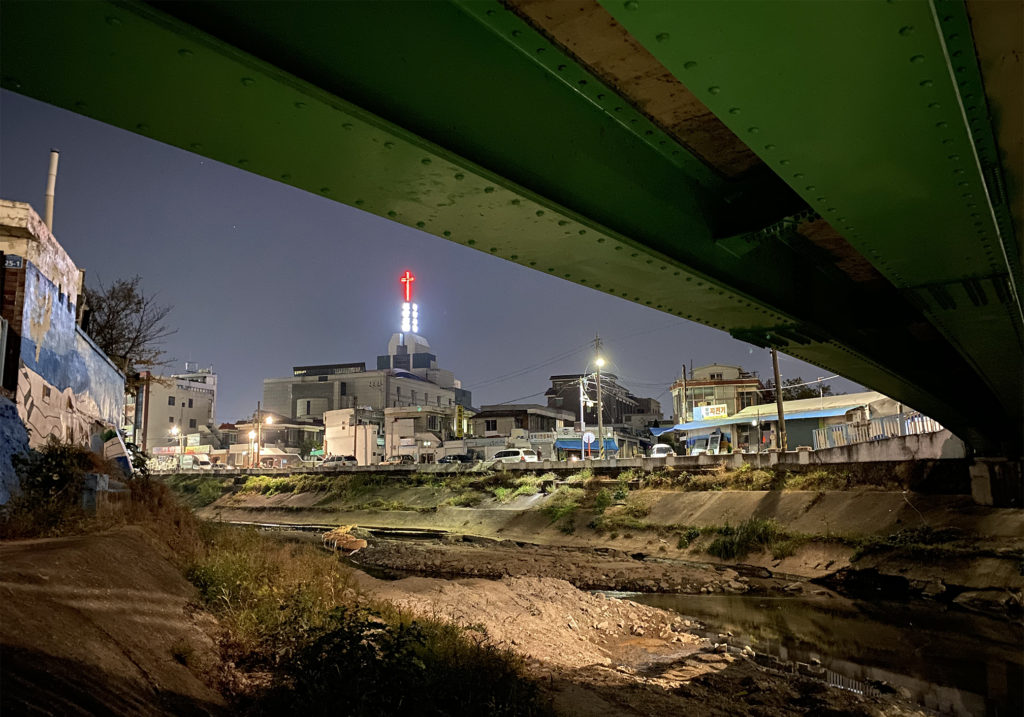
After a few days of incessant downpours, the traffic juncture above the two streams’ confluence – normally one of the busiest parts of the city – became severely flooded with a thick, muddy morass that brought the neighborhood to a standstill. In no time, videos emerged online showing abandoned cars sloshing around in the muck. Possibly the greatest losses occurred underground, where in a single parking garage, 63 cars were destroyed in minutes. Not long after the announcement was made to remove all cars from the apartment complex, the waters rose so high that several of them wouldn’t even start. Among those that did, two stalled at the entrance, trapping the other vehicles inside. All the owners could do was watch in horror as their cars were completely submerged[1].
As of now, a few local businesses located right near the worst of the flooding still sit vacant with their windows smashed to bits. The day after it all happened, I remember walking by the shops and wondering whether it was the churning waters or sloshing cars that shattered their storefronts. Everything in the area was left covered in a thick layer of earthy silt that spread across the road like an alluvium. Even the local Starbucks wasn’t spared from the torrent – it had to close down for a few weeks until it dried out enough to be remodeled. If you need an even better symbol of how quickly civility can cede to nature, during my post-diluvian walk, I spotted a Bentley with mud in its tailpipes and an empty plastic drink sitting on the hood. Evidently, someone had walked by it and, figuring it was ruined, set their trash down on it before walking away.
Gwangju’s Longest Hour (Dongnim-dong)
With this year marking the 70th anniversary since the start of the Korean War, I’d be remiss if I didn’t mention the site of Gwangju’s only battle during the entire conflict. At 4:00 in the morning on July 23, 1950, the Sandong Bridge in Dongnim-dong was detonated ahead of the advancing Korean People’s Army, which had arrived in nearby Jangseong the day before. The bridge was part of National Route 1, which connected the southern port city of Mokpo to Sinuiju bordering China. This made it a crucial thoroughfare for refugees, soldiers, and supplies as communist forces drove south with remarkable speed. It’d taken them just under a month to reach Gwangju since the war’s start on June 25, so the remaining soldiers and policemen charged with defending Gwangju must have been painfully aware of how every minute counted.
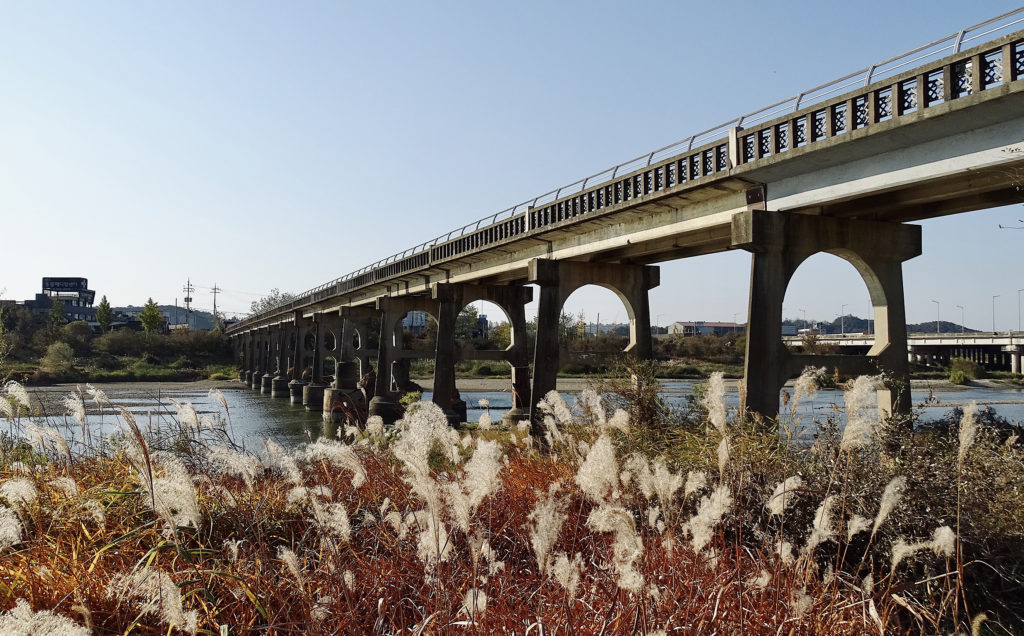
The predawn roar that brought the bridge down marked the beginning of what would be an extremely short-lived battle for Gwangju. In the hours following the detonation, the joint military-police unit formed a battle line along a ridge near the Yeongsan River and waited for the enemy to arrive. Poorly manned and underarmed, the unit was comprised of soldiers who’d retreated from the frontlines, police officers, and even some middle school students. They were no match for what showed up across the river just before noon: three tanks accompanied by enemy infantry. Apparently, these made their way easily across the river, which is often quite shallow in that area, and began firing on the defenders in the direction of the city. The defenders held out for an hour before withdrawing, which gave civilians and refugees precious time to evacuate ahead of the invaders. In the end, about 30 of the city’s defenders were killed and 50 wounded[2].
Though rebuilt since its wartime demolition, the Sandong Bridge’s latest incarnation still looks quite rough by modern standards. Made of concrete, the footpath rests on old piles that even now bear debris scars from the summer inundation. During my last visit in November, I was impressed to see an entire tree still lodged high between two of its support pillars. Today, it’s all part of a very nice riverside park named after the bridge. If you visit, a placard on the bridge explains more about the hour-long battle for Gwangju, including some of the most notable casualties of the fight. To pay homage to the war’s anniversary, I recommend visiting soon while the reed plumes still blanket the banks. You wouldn’t have to stay long – an hour should do.
A Place for Lovers, Loners, and Literati (Singa-dong)
One of my favorite viewpoints in the city sits nestled in a bend along the Yeongsan River in Singa-dong. It’s where one Kim Eon-geo built a pavilion over four and a half centuries ago after retiring from the civil service. He named it Pungyeong Pavilion (풍영정), which roughly translates to “enjoying nature and reciting poetry,” and just so happens to sound a lot like the Korean word for scenery/view (풍경, punggyeong). Enjoying his golden years like a sort of mid-Joseon Dynasty hipster, there Kim would meet up with other creative literary types to discuss whatever 16th-century literati talked about back then. As the pavilion is made mostly of wood, it’s of course been rebuilt time and time again over the centuries in roughly the same spot. Today, it’s a great hideaway for a date or a simple walk – that is, if you can get past the guard.
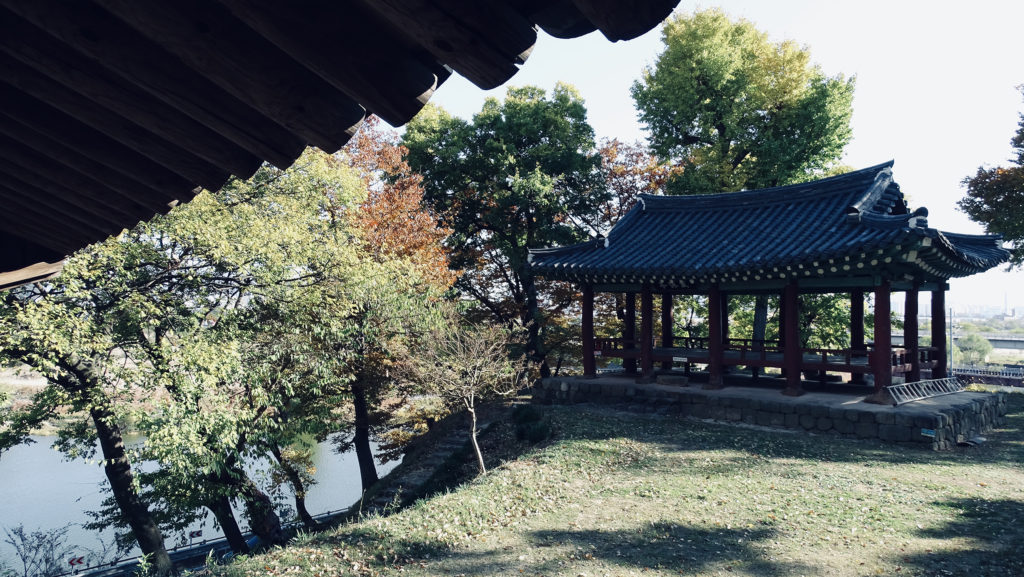
Since I used to live close by, I’d visit Kim’s pavilion from time to time on late-night walks. Because of COVID-19, however, the place has been closed to individual visitors without reservations since summer. On a recent revisit in preparation for this article, I didn’t know that fact and so slipped in through the usual back gate where I always used to enter. I got the feeling that it was closed once I saw an official-looking elderly man enjoying the place all to himself. Immediately sensing I’d get kicked out, I figured I’d snap as many photos as possible before he inevitably approached me, which he soon did. (As they say, it’s better to do first and ask for permission later.) While answering all his gruff, pointed questions about why I was there and how I’d gotten in, I figured he’d kick me out any second – but to my surprise, he didn’t.
Rather than send me off with my tail between my legs, the hoary, old security guard began to take an interest in me, my job, and my relation to Korea. I took this opportunity to ask about the pavilion and then nodded knowingly as he answered at length – despite not understanding half of what he was saying. After listening intently to his detailed history of the pavilion, what I came away with was that it was really old and nobody should ever hire lonely security guards because they talk a lot, even with trespassers. Fortunately, there’s a placard just outside the pavilion that explains most of what he said in both English and Korean. In the end, he never actually had to kick me out of the place; instead, he talked me out of it. I hope regular visits resume next year, as it’s an amazing spot anyone can enjoy.
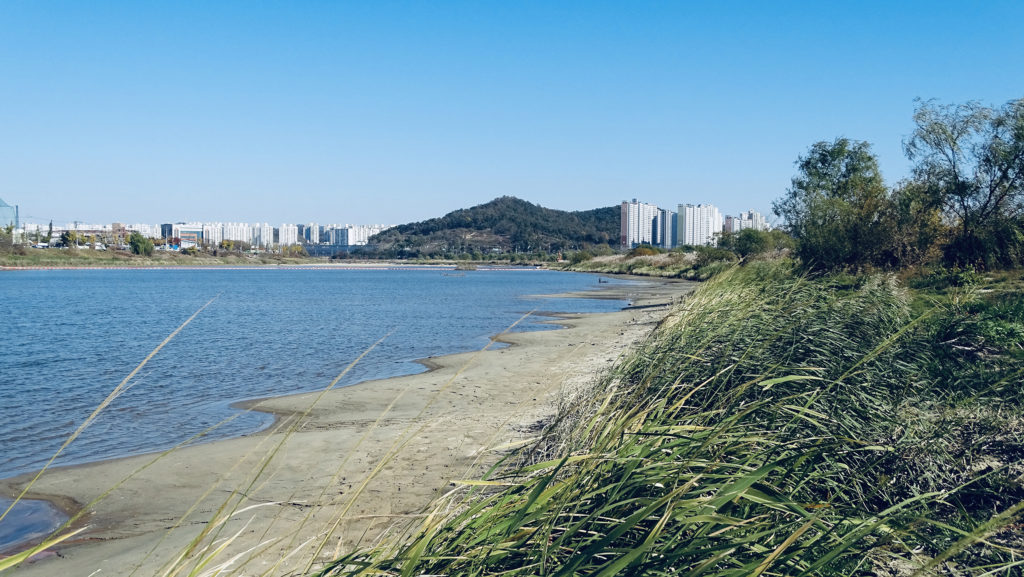
With that, dear readers, we can wrap up another year of being utterly Lost in Gwangju. I truly love this city and writing about all its peculiar places and people, which I hope to do a lot more of next year. Now that a few effective coronavirus vaccines are on the horizon, it’s my hope that at least some of 2021 will be far better than most of 2020. So, everyone, until then stay safe and get lost.
Sources:
1.Seo, C. (2020, August 11). 지하주차장 잠긴 북구 아파트 차량 보상 어떻게? Mudeung Ilbo. http://m.moodeungilbo.co.kr/detail/c3QycN/610679
2.Song, G. (2020, June 18). [6.25전쟁 70년] 1시간 버티며 피난 도와…광주 유일 전적지 산동교. Yeonhap News. https://www.yna.co.kr/view/AKR20200615108900054
THE AUTHOR
Originally from Southern California, Isaiah Winters is a Gwangju-based urban explorer who enjoys writing about the City of Light’s lesser-known quarters. When he’s not roaming the streets and writing about his experiences, he’s usually working or fulfilling his duties as the Gwangju News’ heavily caffeinated chief proofreader.







